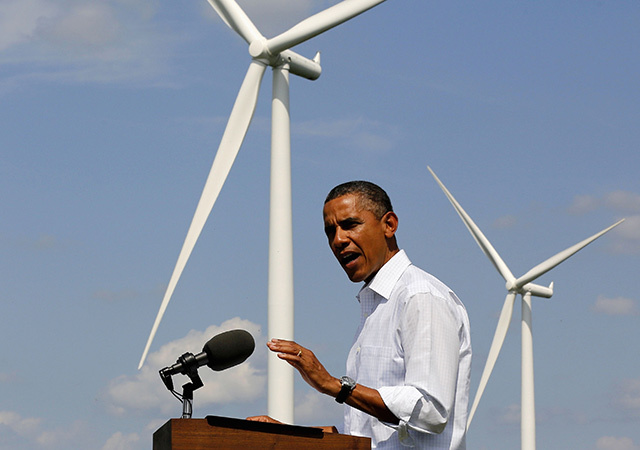
So much for “all the above.” President Obama’s “clean power plan” for combatting climate change, unveiled Aug. 3, makes it clear that the U.S. strategy is to plunge head first into renewable energy — no bridge fuels, no gradual migration to a low-carbon future.
The policy is in stark contrast to 2012, when Obama called for an “all-the-above” energy strategy that would curb carbon emissions while also taking advantage of America’s abundance of natural gas and its technological prowess in nuclear power. It was a balanced approach to diversifying the U.S. fuels portfolio, encouraging innovation on all fronts, ensuring greater energy security and recognizing both the promise and shortcomings of renewables.
Less than four years later, Obama has scrapped that idea for a political power play. One of his biggest challenges is advancing rational policy. No matter how sound the president’s suggestion, the right decries it immediately. An entire political movement has evolved around knee-jerk opposition to all things Obama.
So perhaps the president is making a calculated move here: put forth a plan that puts the Republicans on the defensive and hope that, once the inevitable legal challenges subside, a rational policy emerges.
But there’s also an element of political pandering at work, too. Obama once declared natural gas a bridge fuel to a future of renewable energy, and he even boasted, somewhat inaccurately, about the government’s role in developing hydraulic fracturing. Today, fracking is a four-letter word that environmentalists hurl at any operation involving a drilling rig.
Environmentalists would have howled in protest if the administration had even hinted that natural gas, which produces 50 percent less carbon than coal, has been effective in reducing greenhouse gas emissions from power plants.
As a result, the oil and gas industry is paying for years of dismissing public concerns about fracking. Those fears have now codified into policy.
The plan’s basic approach is the same as the administration outlined last year: it sets limits on carbon emissions and let individual states figure out how to comply with them. As long as carbon output is cut by 32 percent in the next 15 years from 2005 levels, it doesn’t matter how each state gets there.
It sounds great, and many environmental groups still cling to idea that “free market solutions” such as the cap-and-trade system used to defeat acid rain will work for carbon. But a carbon trading scheme is much more broad-based, and open to far more Enron-esque manipulations, with a greater chance for cost increases and a lower chance for success.
The plan is a requiem for domestic coal, and nuclear power gets no love, either. Natural gas, which for the first time in decades has surpassed coal as a generating fuel, gets to no incentives and no promise of an expanded market, although the industry is established enough that it probably doesn’t need such guarantees.
That leaves renewables, which are the main beneficiary. But the renewables fever is also the plan’s biggest potential problem. It’s easy to get caught up in the euphoria of wind and solar as energy panaceas. Costs have plunged. Solar panels now sell for about 60 cents, compared with $4.50 seven years ago. In addition, low interest rates have allowed installers to offer cheap financing to homeowners, triggering an explosion in rooftop solar across the U.S.
The cost of wind farms is falling, too, and more renewable generating capacity is being added globally each year than all fossil fuels combined.
Utilities are restructuring their business models to account for this change, but for all these green dreams, harsh realities remain. The intermittent nature of renewable generation still poses a threat to grid stability and reliability. Natural gas is the solution to this problem because gas plants can ramp up and down quickly to offset fluctuation in renewable generation.
Even if government subsidies for renewables go away, they still may be more expensive because power in wholesale markets trades in increments of an hour or less. During the hours that renewables are producing electricity, the additional output causes prices to fall. That means generators receive less money per kilowatt hour for renewable energy than they do for conventional sources, and this lower price further undermines the economics of renewables.
There are other problems with the plan. While many of the Republican fears of higher costs are overblown, the plan does create the potential for consumers to be stuck paying for coal plants that can no longer be used. Many of these same consumers are also still paying similar “stranded costs” for nuclear plants the government once required utilities to build. The extent of these costs depends on the structure of regional electric markets, but some consumers may end up footing the bill for coal’s demise.
The plan does give the U.S. more credibility in the global climate change debate, and its focus on renewables may also encourage improved battery technology that will reduce grid disruptions someday.
For now, though, the U.S. still desperately needs a comprehensive energy plan that accommodates the rise of renewables yet recognizes their technological and economic limitations. Instead, the president offers a plan that’s heavy on green dreams and politics and short on realistic policy.
Loren Steffy is a managing director with the communications firm 30 Point Strategies. He is a writer at large for Texas Monthly and the author of Drowning in Oil: BP and the Reckless Pursuit of Profit.
Recommended for you
